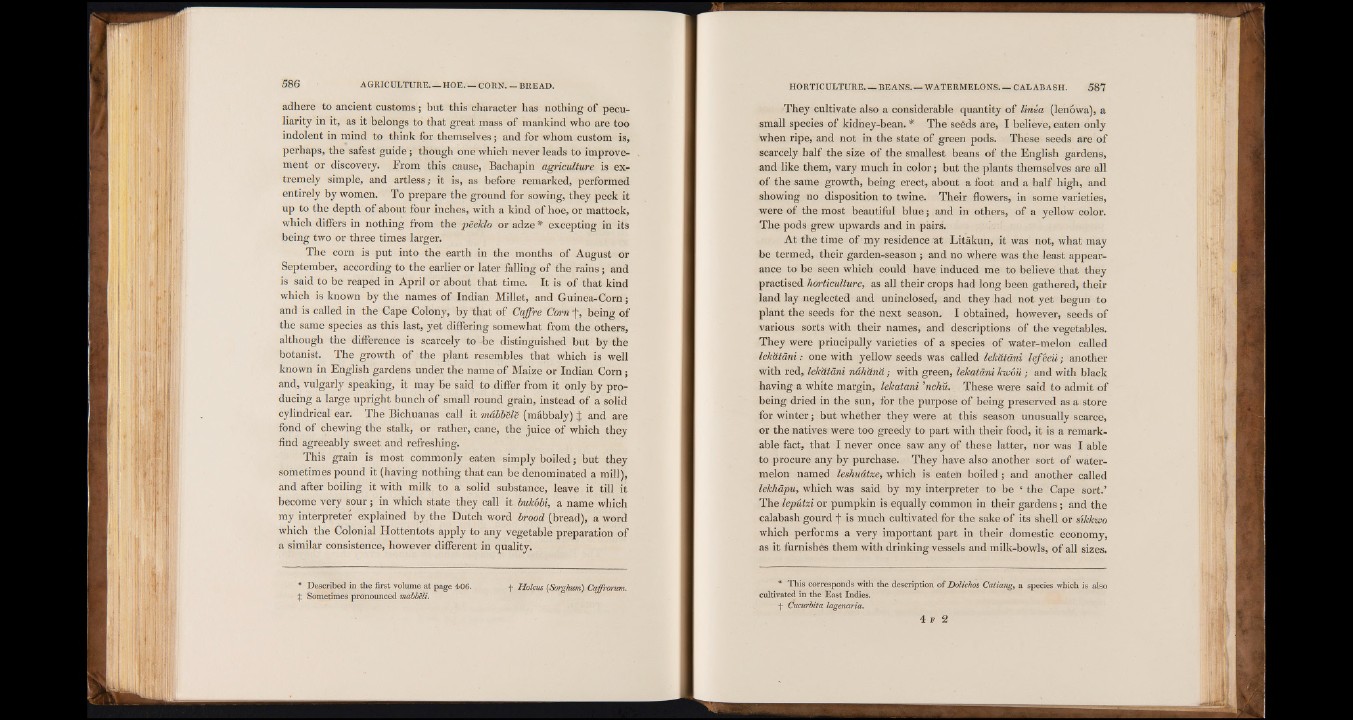
5 86 AGRICULTURE HOE. — CORN. — BREAD.
adhere to ancient customs; but this character has nothing of peculiarity
in it, as it belongs to that great mass of mankind who are too
indolent in mind to think for themselves; and for whom custom is,
perhaps, the safest guide ; though one which never leads to improvement
or discovery. From this cause, Bachapin agriculture is extremely
simple, and artless; it is, as before remarked, performed
entirely by women. To prepare the ground for sowing, they peck it
up to the depth of about four inches, with a kind of hoe, or mattock,
which differs in nothing from the peeklo or adze * excepting in its
being two or three times larger.
The com is put into the earth in the months of August or
September, according to the earlier or later falling of the rains; and
is said to be reaped in April or about that time. It is of that kind
which is known by the names of Indian Millet, and Guinea-Corn;
and is called in the Cape Colony, by that of Caffre Com f, being of
the same species as this last, yet differing somewhat from the others,
although the difference is scarcely to lie distinguished but by the
botanist. The growth of the plant resembles that which is well
known in English gardens under the name of Maize or Indian Corn;
and, vulgarly speaking, it may Ee said to differ from it only by producing
a large upright bunch of small round grain, instead of a solid
cylindrical ear. The Bichuanas call it mdbbele (mabbaly) % and are
fond of chewing the stalk, or rather, cane, the juice of which they
find agreeably sweet and refreshing.
This grain is most commonly eaten simply boiled; but they
sometimes pound it (having nothing that can be denominated a mill),
and after boiling it with milk to a solid substance, leave it till it
become very sour; in which state they call it bukobi, a name which
my interpreter explained by the Dutch word brood (bread), a word
which the Colonial Hottentots apply to any vegetable preparation of
a similar consistence, however different in quality.
* Described in the first volume at page 406.
X Sometimes pronounced mabbeli. f Holcus (;Sorghum) Caffronm.
HORTICULTURE. — BEANS. —WATERMELONS CALABASH. 5 87
They cultivate also a considerable quantity of linia (lenôwa), a
small species of kidney-bean. * The seëds are, I believe, eaten only
when ripe, and not in the state of green pods. These seeds are of
scarcely half the size of the smallest beans of the English gardens,
and like them, vary much in color ; but the plants themselves are all
of the same growth, being erect, about a foot and a half high, and
showing no disposition to twine. Their flowers, in some varieties,
were of the most beautiful blue ; and in others, of a yellow color.
The pods grew upwards and in pairs.
At the time of my residence at Litâkun, it was not, what may
be termed, their garden-season ; and no where was the least appearance
to be seen which could have induced me to believe that they
practised horticulture, as all their crops had long been gathered, their
land lay neglected and uninclosed, and they had not yet begun to
plant the seeds for thé next season, I obtained, however, seeds of
various sorts with their names, and descriptions of the vegetables.
They were principally varieties of a species of water-melon called
lekâtâni : one with yellow seeds was called lekâtâni leféeü ; another
with red, le/câtâni nâhânâ ; with green, lekâtâni kwôü ; and with black
having a white margin, lekatani 'nchu. These were said to admit of
being dried in the sun, for the purpose of being preserved as a store
for winter ; but whether they were at this season unusually scarce,
or the natives were too greedy to part with their food, it is a remarkable
fact, that I never once saw any of these latter, nor was I able
to procure any by purchase. They have also another sort of watermelon
named leshuâtze, which is eaten boiled ; and another called
lekhâpu, which was said by my interpreter to be ‘ the Cape sort.’
The lepûtzi or pumpkin is equally common in their gardens ; and the
calabash gourd f is much cultivated for the sake of its shell or sikkwo
which performs a very important part in their domestic economy,
as it furnishès them with drinking vessels and milk-bowls, of all sizes.
* This corresponds with the description of Dolichos Catiang, a species which is also
cultivated in the East Indies,
f Cucurbita lagenaria.
4 f 2